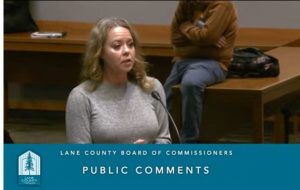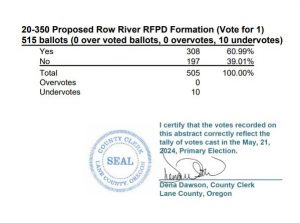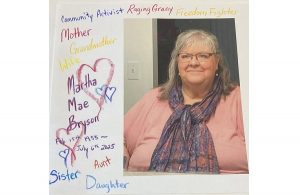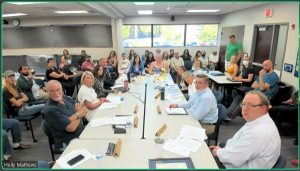Ice storm lessons learned: Cottage Grove
8 min read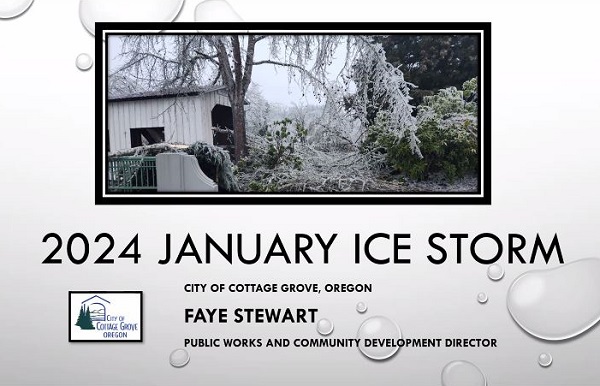
The top lessons learned from the ice storm: Encourage programs that support neighbors helping neighbors, and tell your community in advance where to go for shelter, because you may not be able to reach everyone when power and communications go down. At the Lane Preparedness Coalition March 14:
Faye Stewart (Cottage Grove, Public Works director): So Saturday morning on Jan. 13, normal feel, I looked out, looked like it was just starting to rain. I went outside about 1:30 that afternoon, and wow, there was icicles forming on all the trees and all the wires and everything. And about 1:30, 2:00, crews started to come in.
[00:00:37] Trees were starting to fall, blocking the street. We started moving those out of the way. We had one pump station or lift station that was out of power. So we had to call in a crew about 3:30 to start operating it with backup generation.
[00:00:54] And so that’s when it all started. By 6:30 that evening, everybody was out of power. We declared that we needed a warming shelter. The only place that we could have a warming shelter in our community was the city hall.
[00:01:08] We had backup power for the city hall, for our water treatment plant, wastewater treatment plant, and our two pump stations—water pump stations. So, we stood up a warming shelter, tried to get the information out, notified the local fire department and various different entities. The other place that had power—but was running at 50%—was the hospital.
[00:01:32] So our generators are, all of them are diesel-powered and all of them have a run capacity of about two days. And what was transpiring on Sunday and late Sunday afternoon was that streets and the roads were all impassable. Freeways were closed. We were on the phone trying to see, ‘Hey, our normal supplier of diesel that comes and fills our tanks was not able to even get out of their yard.’
[00:02:00] So, I’m sitting there going, ‘Oh, geez. Okay. What are we going to do? Because we’ve got a finite amount of time before our generators start to shut down.’ And I did learn that one service station or commercial fuel stop in Cottage Grove did have backup power, and that’s Welton Weld, and so I went over and I tested my fuel card, and sure enough, it worked.
[00:02:21] And I was able to borrow a couple of additional fuel cards and give them to our staff so that the Police Department and our Public Works teams could respond to emergencies and our utility crews would be able to continue to do their work.
[00:02:36] And fortunately for us, and Amanda’s here with us, when she was with the city, she applied for a SPIRE grant and was able to get us, the city of Cottage Grove, a 250-gallon diesel fuel trailer. So our team was delivering fuel to all of our generators, 24 hours, just to keep them up and operational.
[00:02:55] Our biggest user of diesel at that time was our wastewater treatment plant. It’s an 800-kW plant. It burns about 60 gallons an hour of fuel. And so that was the biggest one that we had to keep going. Our team had to essentially do that for five days because we weren’t able to bring fuel into the community until late on the fifth day to start transitioning to our fuel provider to do that.
[00:03:25] One of the impacts that was really difficult for the city of Cottage Grove was, the hospital was only able to power their facility at 50%, which was their emergency room and some of their beds that they have patients in. And they were receiving at the time about 30 individuals a day coming in that had direct injuries or consequences from the storm.
[00:03:49] There was carbon monoxide poisoning. There was a lot of fractures and breaks. There was heart issues. In fact, in our surrounding area, we experienced five deaths that were directly related to the storm. Two of them were house fires and three of them were carbon monoxide poisoning.
[00:04:06] John Q: After a harrowing weekend, Cottage Grove was making progress, clearing downed trees and restoring downed utility lines. Then the second ice storm moved in.
[00:04:14] Faye Stewart: We get through the weekend, Monday comes, and then Monday night it starts raining again. And Tuesday I wake up and it’s like every gain that we made was all reversed—so all the lines that people were standing up, all the things. And then the damage was just multiple times worse when we got that second wave of ice that was forming.
[00:04:39] So then everybody kind of started over. We kept talking with Pacific Power, you know: ‘When are we going to be able to possibly see some power start to get restored?’ Because we were hoping to transition our shelter over to our community center, but without any power there, it wasn’t even possible. So we were pretty much the only provider for that.
[00:05:01] Pacific Power, on day five, they were able to bring a two-megawatt generator into the community. They got it hooked up and then they were able to supply full power to the hospital. And that’s when our two service stations close to the hospital were able to open up and then people were actually started to be able to purchase fuel in the community.
[00:05:23] And during this time Safeway was probably, I think, the first convenience store that was able to open without power. They had to bring some sort of a generator in. They did the bare essentials, but because the power had been off for so long, the only thing they could provide is nonperishable foods. Everything that was perishable, they couldn’t sell. But at least there was a place to purchase.
[00:05:46] We had Bi-Mart and Cascade Home Center. They were just operating without power. They were able to open their doors and try to facilitate folks as much as they can to buy supplies.
[00:05:58] So once we got the power started and restored, that was on late day six. So day seven when we woke up, we had essentially probably 90% of Cottage Grove was back on, on power. That meant that we had planned with Red Cross to transition and Red Cross took over our shelter operation.
[00:06:19] Once we transitioned everybody that was in City Hall, there was probably about 42 individuals there at that point to transition over. We had people in the shelter anywhere from upwards of 50 to, we probably averaged about 35 folks over that period of time until folks were able to get back to their sites.
[00:06:38] John Q: Faye described contracting with crews, clearing the downed trees, staging 50,000 cubic yards of debris, chipping, then distributing the chips free within 10 miles of town. With lessons learned:
[00:06:52] Faye Stewart (Cottage Grove): I wanted to touch on lessons learned that I personally believe that we need to spend some time on and maybe we as a collective group need to work together on.
[00:07:04] I need to figure out a better communication plan and have people better prepared. When we have our emergency preparedness fair, and whenever we had the ability to get information out there, we need to get people programmed that if this happens again, you can go here. Even if you don’t get a message that it’s open, go here if you need help.
[00:07:22] One of the things that I’m looking forward to is: Lane County has been aggressive about trying to establish resilience centers. I think they’re shooting to create six hubs in Lane County. And we’ve offered up the community center to be one of them. If we can get our heating and cooling system replaced and get a backup generator and enough supplies there for 10 days, that can be the go-to site or one of the go-to sites in our community as these events happen in the future.
[00:07:54] The other thing I want to do is look at getting backup power generation to our lift stations. So we had Public Works crews that were moving generators from two sites—two lift stations because we have four—using the backup generator to keep them pumped down. They just go back and forth, pumping them down.
[00:08:13] And then over at Middlefield, we have two and we had a team there, two individuals that were using actually trash pumps to pump the lift station nonstop during the day.
[00:08:23] So I need to get that taken care of, get those on backup and look for, is it prudent to hook them up to natural gas because natural gas appeared to be in this instance, a resource that would have powered and we wouldn’t have had the sleepless nights worrying about whether or not we were going to run out of diesel, or how we were going to do that.
[00:08:45] The other thing I’ve thought about is working with that commercial distributor and saying, ‘Hey, when we have a situation like this, can you dedicate one of your large tanks, your 10,000-gallon tanks, to the city for diesel so that we can tap into it? I know as a group we’ve talked about establishing maybe a couple of different locations for diesel fuel.
[00:09:10] And if I can’t even get out of Cottage Grove to get to Goshen, that doesn’t do us any good. So maybe we should be thinking about trying to create those fuel supplies closer to our community so that we can tap into them.
[00:09:23] Another is trying to encourage our neighborhoods to create their own disaster-what-do-they-do (plan). One of the things that’s really evident is probably the most effective way to help people in this is neighbors help neighbors—we help each other. Back at our house, we had a family come in and move in with us during that period of time.
[00:09:42] And then as I think about, lastly, as I think about the potential of an actual earthquake, when I was a commissioner, they said, ‘Well, you need to prepare for 30 days.’ Well, I have to tell you, we barely made it six days. So I don’t know what kind of preparation we’re going to have to make it 30 days, but it’s going to be a huge, huge challenge.
[00:10:02] John Q: He estimated Cottage Grove’s total cost at over $2 million. He was asked: How did people know to go to City Hall?
[00:10:10] Faye Stewart (Cottage Grove): The only way we were able to push out the information was, we were able to post to Facebook to people that could get it. But it was essentially our fire department, our CERT (Community Emergency Response Team), we have a small CERT team in the community. They banded up and started going around door to door checking, because there was no communications. And we did have some pretty active city councilors and staff that were going out and trying to spread the word.
[00:10:34] So that is one of the things that we have to do better. We need to have a guaranteed place where people can go and people need to know whether you’re communicated with or not, this is where you go to. So that’s what I would like to see happen in the future.
[00:10:48] John Q: Lessons learned from the ice storm in Cottage Grove: Let people know in advance where to go for shelter and information when power and communications fail. And the most effective help is: Neighbors helping neighbors.
[00:11:01] Sign up for your local Community Emergency Response Team, the CERTs, and join your local neighborhood association, to start meeting nearby neighbors.
